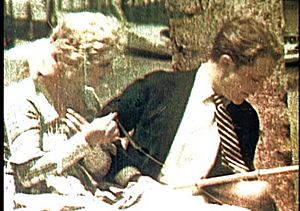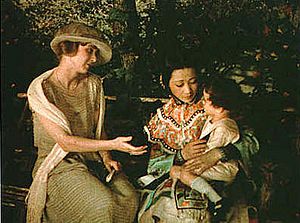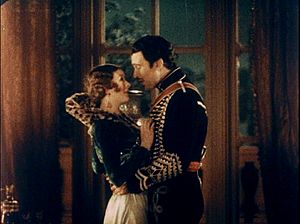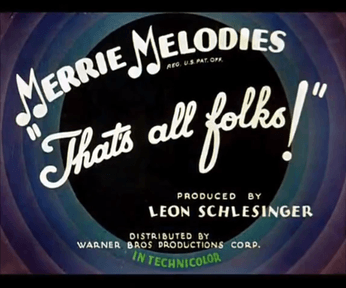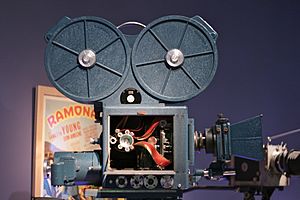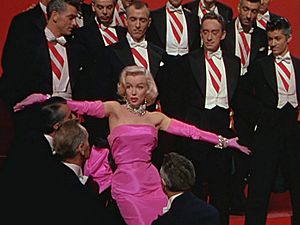Technicolor facts for kids
Technicolor is a special way of making movies in color. It started in 1916 and got better over many years.
The most famous version, called "three-strip Technicolor," began in the early 1930s. It used three black-and-white films inside a special camera to capture all the colors. This method was used until the mid-1950s. After that, regular color film was used, but Technicolor labs could still make those unique, vibrant prints.
Technicolor was the most popular color process in Hollywood during its "Golden Age." It was known for its very bright and rich colors. Many famous movies used it, like The Wizard of Oz (1939), The Adventures of Robin Hood (1938), and Gone with the Wind (1939). Animated films like Snow White and the Seven Dwarfs (1937) also used it.
The name "Technicolor" comes from the Massachusetts Institute of Technology. That's where the company's founders, Herbert Kalmus and Daniel Frost Comstock, studied.
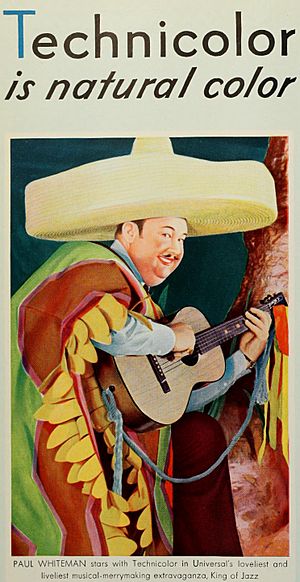
Contents
What is Technicolor?
The word "Technicolor" can mean a few different things:
- Technicolor: This is the main company that has been around since 1914. It covers all the different ways of making color films and other services.
- Technicolor Labs: These are special film labs around the world. They develop, print, and transfer films using many different color processes, including Technicolor's own methods.
- Technicolor Process: This refers to the different camera systems used to film movies in color. The most famous was the "three-strip" process, used from 1932 to 1955.
- Technicolor IB Printing: This is a special way of making color prints using dyes. These dyes are very stable and last a long time. This method was used from 1928 to 2002.
- Prints or Color by Technicolor: Since 1954, when new color films like Eastmancolor became popular, this phrase means that the film was printed using the Technicolor dye process, even if it wasn't filmed with a Technicolor camera.
How Technicolor Started
Herbert Kalmus and Daniel Frost Comstock, along with W. Burton Wescott, started a research company in 1912. They became very interested in making movies in color. This led them to create Technicolor in Boston in 1914.
In 1921, Wescott left the company.
Early Two-Color Technicolor
Process 1: The First Try
The first Technicolor system (Process 1, 1916) used two colors: red and green. A special camera split the light to record two images at once on one black-and-white film strip. One image was through a red filter, the other through a green filter.
To watch the movie, a special projector was needed. It had two lenses and filters to combine the red and green images on the screen. This was first shown in New York in 1917.
Technicolor made only one movie using Process 1, called The Gulf Between (1917). This system was difficult to use because a technician constantly had to adjust the projector. This made it not very practical.
Process 2: Subtractive Color Begins
Technicolor then focused on a new method called "subtractive color." This led to Process 2 (1922). The camera still used a beam-splitter to record red and green images on one film strip.
The big change was how the prints were made. The red and green images were printed onto separate film strips. These strips were then toned with colors opposite to the filters: orange-red for green images, and cyan-green for red images.
These two thin prints were then glued together back-to-back. This meant no special projector was needed, as the colors were already in the film. The Toll of the Sea (1922) was the first widely released film using Process 2.
Other major films used Process 2 for color scenes, like The Ten Commandments (1923) and Ben-Hur (1925). The Black Pirate (1926) was the third full-length movie made entirely in Process 2.
However, Process 2 had problems. Because the images were on both sides of the film, it was hard to keep both perfectly in focus. The film also tended to curl, which made the picture go in and out of focus. Prints were also easily scratched, and the scratches were very noticeable. Technicolor knew this wasn't perfect and kept working on improvements.
Process 3: Dye Transfer Printing
Technicolor Process 3 (1928) was a big step forward. It got rid of the problem of gluing two films together. Instead, it used a "dye-transfer" method. The camera was similar to Process 2, still recording red and green images.
In the lab, these images were used to create two special "matrix" films. These matrices were like gelatin molds. One matrix was soaked in cyan-green dye, and the other in orange-red dye. Then, these dye-soaked matrices were pressed onto a blank film strip. The blank film "soaked up" the dyes, creating the final color print. This was called "dye imbibition."
The first full movie made with Process 3 was The Viking (1928). Many early "talkies" (movies with sound) also used Process 3, like On with the Show! (1929), which was the first all-talking color movie.
In 1931, Process 3 was improved. It made colors more vivid and removed tiny specks from the screen. This also made it cheaper to use. Warner Bros. and Radio Pictures made several films with this improved process. However, the Great Depression made studios cut back on expenses, and color films became less common for a while.
Sadly, most of the original films from Process 2 or 3 no longer exist. Many were thrown away in the 1940s to save space.
The Famous Three-Strip Technicolor
Process 4: Full Color Arrives
Technicolor had dreamed of a full-color process since 1924. By 1932, they had perfected a new three-color camera. This camera could capture a full range of colors, not just red and green. This new process, called Process 4 or "three-strip Technicolor," was used until 1955.
The three-strip Technicolor camera was special. It had a prism that split the light coming through the lens. This light was then sent to three separate rolls of black-and-white film. Each roll recorded a different part of the color spectrum: red, green, or blue.
After filming, each of the three black-and-white negatives was used to create a "matrix" film. These matrices were then soaked in dyes that were opposite to the colors they recorded: cyan for red, magenta for green, and yellow for blue.
Finally, these three dye-soaked matrices were pressed onto a single clear film strip. This strip absorbed the dyes, building up the complete color image. This "dye imbibition" was a mechanical printing process, not photographic.
Disney's Early Use
Herbert Kalmus convinced Walt Disney to use the new three-strip process for his cartoon Flowers and Trees (1932). Disney saw how amazing the full-color Technicolor looked. He then signed an exclusive contract to use the process for animated films until September 1935. This meant other cartoon studios couldn't use it.
Flowers and Trees was a huge hit and won the first Academy Award for Best Animated Short Film. All of Disney's Silly Symphony cartoons after 1933 used this process. Three Little Pigs (1933) was so popular that it even overshadowed the main movies it played with! Hollywood started talking about color film again.
For cartoons, Technicolor later developed an "SE" (successive exposure) process. This meant one black-and-white film strip was used, and each animation drawing was photographed three times, once through a red, green, and blue filter.
Bringing Color to Hollywood Movies
Studios wanted to use three-color Technicolor for live-action movies, but they needed to be sure it would work. The cameras were bulky, and the film needed a lot of bright lights. This made studios a bit unsure.
In 1933, Technicolor and RKO Pictures announced plans to make three-strip Technicolor films. The first live-action use of three-strip Technicolor was in a musical scene in the movie The Cat and the Fiddle (1934).
The short film La Cucaracha (1934) is often called the first live-action short made entirely in three-strip Technicolor. It cost $65,000, which was four times more than a black-and-white short. But it was a success and showed that the new Technicolor could work for live-action films.
Becky Sharp (1935) was the first full-length movie filmed entirely in three-strip Technicolor. At first, it was only used indoors. But in 1936, The Trail of the Lonesome Pine became the first color movie with outdoor scenes, and they looked amazing. The huge success of Disney's Snow White and the Seven Dwarfs (1937) finally convinced all the major studios.
Challenges of Three-Strip Technicolor
One big problem with the three-strip process was that the cameras were very large and noisy. Studios couldn't buy Technicolor cameras; they had to rent them. With the camera came Technicolor staff, including a "color supervisor." This supervisor made sure that sets, costumes, and makeup looked good with the Technicolor system. Natalie Kalmus, the ex-wife of Herbert Kalmus, was often this supervisor. Directors sometimes found her difficult to work with.
Because the camera split the light, less light reached the film. This meant early Technicolor movies needed much brighter lights than black-and-white films. It's said that the sets for The Wizard of Oz were often over 100°F (38°C) because of the hot lights! Some actors even said their eyes were damaged by the intense light.
All this extra lighting, plus using three times the amount of film, made Technicolor movies very expensive to make.
New Color Films and Technicolor's Change
In the mid-1930s, new color films like Kodachrome (for home movies) and Agfacolor (in Germany) were introduced. These films recorded all three primary colors on one strip of film. In 1941, Technicolor introduced Monopack, a single-strip color film for shooting outside the studio, where the big three-strip camera was not practical.
In 1950, Eastman Kodak released its own 35mm color film for movies, called Eastmancolor. By 1952, Eastman Kodak also had a high-quality color print film. This meant studios could make color prints using standard methods, without needing Technicolor's expensive dye process.
However, Technicolor labs quickly adapted. They found a way to use Eastmancolor negatives to make their special dye-transfer prints. Foxfire (1955) was the last American movie filmed with a Technicolor three-strip camera.
By the mid-1960s, the dye-transfer process became too expensive and slow in the United States. More and more movie theaters needed prints quickly. While Technicolor prints had amazing color, the speed and lower cost of other printing methods won out. One of the last American films printed by Technicolor was The Godfather Part II ((1974).
The Technicolor dye-transfer plants in the US and Italy closed down in the late 1970s and early 1980s. The equipment from the British plant was sold to China, where it was used for many Chinese and Hong Kong films until 1993.
Technicolor Today
Bringing Back Dye Transfer Printing
In 1997, Technicolor brought back its dye-transfer process for film printing. This improved version was used for restoring classic films like The Wizard of Oz and Gone With the Wind.
It was also used for some big new Hollywood movies, including Toy Story 2 and Pearl Harbor. However, the dye-transfer process was stopped again in 2002 when Technicolor was bought by another company.
Technicolor for Film Preservation
The dye-transfer process is very important for preserving old films. The dyes used in Technicolor prints are very stable. This means Technicolor prints keep their original colors for decades if stored properly. Other color prints made before 1983 can fade quickly, sometimes turning brownish-red in just a few years.
Also, the original three-strip camera negatives are black-and-white, which means they last a very long time. This is great for making new digital versions of old movies. For example, the original Technicolor negatives for Star Wars were used to help create the 1997 Special Edition.
One challenge with old Technicolor negatives is that the three film strips can shrink at different rates. But today, digital technology can fix this by resizing the shrunken negatives to line them up perfectly.
Technicolor Now
The Technicolor company continued to be very successful in film processing. Later, it got involved in making CDs, VHS tapes, and DVDs, and in digital video.
In 2010, the company that owned Technicolor, Thomson Multimedia SA, changed its name to "Technicolor SA."
In 2020, Technicolor filed for a type of bankruptcy protection in the United States, partly because of the COVID-19 pandemic.
In 2022, Technicolor SA split into two separate companies. One part, which handles internet and video solutions, is now called Vantiva. The other part, which focuses on visual effects and animation, is called Technicolor Creative Studios.
The unique look of dye-transfer Technicolor is still used in Hollywood today. Sometimes, movies set in the mid-20th century, like The Aviator (2004), use digital effects to copy the old Technicolor style.
You often see "Color by Technicolor" or "Prints by Technicolor" in the credits of movies.
See also
 In Spanish: Technicolor para niños
In Spanish: Technicolor para niños
- List of film formats
- List of color film systems
- Imbibition
- Dye-transfer process
- List of early color feature films
- List of three-strip Technicolor films


